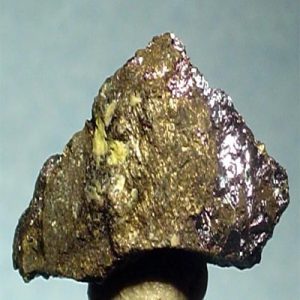Valleriite
Valleriite is an uncommon hydroxy-sulfide (sulfosalt) of iron, copper, magnesium and aluminum. It is often found associated with other similar sulfide minerals such as Bornite, Chalcopyrite, Cubanite, Marcasite, Pentlandite, Pyrite andPyrrhotite. Valleriite is an alteration product of Chalcopyrite or other copper minerals. It is opaque, bright to dark bronze colored with metallic luster, often resembling Pyrrhotite, but it is very soft, with a Moh’s hardness of about 1.
Valleriite was named to honor Johan Gottschalk Wallerius (Vallerius) (1709–1785), Swedish chemist and mineralogist. In 1750, Wallerius was elected member of the Royal Swedish Academy of Sciences. He is regarded as the founder of agricultural chemistry, mainly based on the significance of his work Agriculturae fundamenta chemica published in 1761.
Valleriite distribution: an inconspicuous mineral, now recognized from a number of localities in addition to those listed here. In Sweden, in Kopparberg, from the Aurora mine, Ljusnarsberg [TL], and at Kaveltorp. In South Africa, in Transvaal, from the Loolekop carbonatite, Phalaborwa, and at the Mooihoek and Onverwacht pipes, in the Merensky Reef, Bushveld complex. From near Pefkos, Cyprus. In Canada, at the Little Chief mine, near Whitehorse, Yukon Territory; in the Marbridge mine, Malartic, Quebec; and at Sudbury, Ontario. In the USA, from the Elizabeth mine, South Strafford, Strafford County, Vermont; in the Pima mine, near Tucson, Pima County, and at the Christmas mine, Gila County, Arizona; from the Continental mine, Fierro, Grant County, New Mexico. In Russia, in the Talnakh area, Noril’sk region, western Siberia; from the Kovdor and Monchegorsk massifs, Kola Peninsula. At Alnalyk, Uzbekistan. In the Akagane mine, Iwate Prefecture, Japan. From Wannaway, Western Australia. On the East Pacific Rise (21 N).
| Chemical Formula: | (Fe2+,Cu)4(Mg,Al)3S4(OH,O)6 also: 4(Fe,Cu)S • 3(Mg,Al)(OH)2 |
| Iron Copper Magnesium Aluminum Hydroxy Sulfide | |
| Molecular Weight: | 475.92 gm |
| Composition: | Magnesium | 8.68 % | Mg | ||
| Aluminum | 7.37 % | Al | |||
| Iron | 25.82 % | Fe | |||
| Copper | 24.03 % | Cu | |||
| Hydrogen | 0.42 % | H | |||
| Sulfur | 26.95 % | S | |||
| Oxygen | 6.72 % | O | |||
| 100.00 % |
| Crystallography: | Trigonal – Hexagonal Scalenohedral |
| Crystal Habit: | Massive, as nodules, to 5 mm; also in tiny splinters, very thin flakes, and thin crusts. |
| Twinning: | None |
| Cleavage: | Excellent on {0001} |
| Fracture: | n/a |
| Tenacity: | Brittle |
| Moh’s Hardness: | < 1.0 – 1.5; less than graphite |
| Density: | 3.14 (g/cm3) |
| Luminescence: | None |
| Radioactivity: | Not Radioactive |
| Color: | Bronze-yellow to dark gray, resembling Pyrrhotite |
| Transparency: | Opaque |
| Luster: | Metallic to sub-metallic |
| Refractive Index: | R1–R2: (400) 10.5–11.1, (420) 10.8–11.3, (440) 10.7–12.7, (460) 10.6–14.2, (480) 10.5–15.8, (500) 10.5–17.3, (520) 10.3–18.8, (540) 10.3–20.1, (560) 10.3–21.3, (580) 10.2–22.4, (600) 10.3–23.4, (620) 10.3–24.4, (640) 10.3–25.1, (660) 10.4–25.8, (680) 10.3–26.4, (700) 10.3–26.9 |
| Birefringence: | 0.000 (opaque) |
| Dispersion: | n/a |
| Pleochroism: | Strong; pale yellow to deep brown |
| Anisotropism: | Strong; golden yellow |


